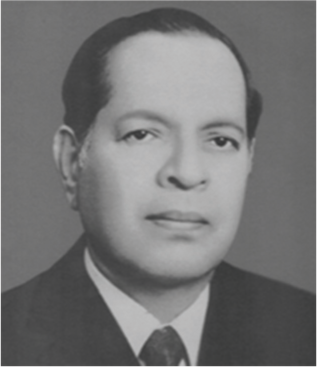Translate this page into:
Dr. B. M. Ambady: A teacher extraordinary
*Corresponding author: Anisha Kanhirangattil Janardhanan, Department of Dermatology, Baby Memorial Hospital, Kozhikode, Kerala, India. anisha_janardhanan@yahoo.com
-
Received: ,
Accepted: ,
How to cite this article: Sugathan P, Janardhanan AK. Dr. B. M. Ambady: A teacher extraordinary. J Skin Sex Transm Dis 2021;3:173-4.

Dr. Bhaskara Menon Ambady was born on December 28, 1912, in Tripunithura, Kerala. He secured his MBBS degree from the Madras University and completed his house surgeoncy in 1938. In 1940, he was commissioned in the Indian army in the Indian medical service and later the Indian army medical corps and was sent overseas. His participation in the overseas battles in the Second World War left him with shell shock, burst eardrum, and fracture of the left ankle. He returned to India in 1943, but continued in the Indian army and was posted in various military hospitals till his release in February 1946. The same year, he was appointed as a venereologist in Government Hospital, Ernakulam. In 1949, he went abroad, first to the USA and then to England, where he pursued postgraduate studies in dermatology, venereology, and leprosy. On his return, he joined Kerala government medical services. He worked initially in the Government General Hospital, Ernakulam. In 1954, he joined Government Medical College, Thiruvananthapuram, and rendered his services as a teacher and then as the head of the department of dermatology and venereology. He retired from service in 1967 as the superintendent of the Thiruvananthapuram Medical College Hospital.
By all accounts, Dr. Ambady was a dynamic, shrewd, intelligent, kind, and patient-friendly dermatologist. He was far ahead of his time and in those days when a dermatologist’s armamentarium included only four ointments, two lotions, one liniment, one cream, and a few antibacterial agents, he had evolved many innovative ideas for treating his patients.[1,2] In all matters clinical, his acumen and judgment were sound.[3-7] His bedside manners were exemplary. He was one of the few specialists of the time who was truly compassionate to his patients, whatever be their social or financial status, with no thought of monetary benefits.[8] Apart from his work at the medical college and his practice at home, he also used to find time for house calls for the really sick patients.[8,9]
He was always a great support to his junior colleagues and subordinates. He encouraged the publication of papers and would always help his less experienced colleagues to publish papers. He also encouraged attending conferences. A fond memory shared by all his junior colleagues is that of the many journeys in his car to meetings of the specialty in various towns in the state. He took fatherly care of female colleagues who travelled with him.[10] He also made it a point to take group photographs each time someone from the department retired or was transferred to another place and to frame and hang those photographs in the department with their names printed on it.
His leadership qualities were evident from a young age. The outstanding centenary celebrations of Madras Medical College in 1935 were brought about by the efforts of Dr. Ambady, then general secretary of the college union. “He breathed and suffused an air of confidence. He infected others with his enthusiasm, and all worked for him ungrudgingly, willingly, and happily” described Dr. R Ananthanarayan, a friend and colleague.[8] In later life, he continued to exercise his wonderful ability to lead. He had rendered his services as the secretary and vice-president of Kerala branch of the Indian Medical Association (IMA). He was also instrumental in acquiring the land for and building the IMA House in Red Cross Road, Thiruvananthapuram. He always emphasized the importance of associating with other branches of medicine, for a dermatologist’s overall development. He used to say, “We are not the tail end of medicine, but part and parcel of the whole.” He played a leading role in the amalgamation of various dermatological societies of India into the unified Indian Association of Dermatology, Venereology, and Leprosy (IADVL) in 1973 and was the national president of the IADVL during 1974–1975.[11] The first annual conference of the association under the banner of the IADVL, independent of the Association of Physicians of India, was held in 1975 at Thiruvananthapuram, under the chairmanship of Dr. B. M. Ambady, and was extremely well received.
He was a well-known personality in Thiruvananthapuram, not only as a great doctor, but also as a keen sportsman, and an active member and office bearer of many sports organizations. A Lion and a Freemason, he played a significant part in the social life of Thiruvananthapuram.[8]
He passed away on September 14, 1975. “The Ambadi Oration,” the most prestigious award in India to be annually presented to an Indian dermatologist, serves to introduce to the new generation of dermatologists, the legend that was Dr. Ambady. And as the saying goes, “A teacher never dies.” Many of his qualities, as a teacher and as a doctor, have been imprinted into the minds of his colleagues and students, including me (Dr. P Sugathan). Through us he lives.
Acknowledgment
The authors would like to thank Smt. Leela Muraleedharan, Dr. Ambady’s eldest daughter, for providing the details of his early life and Army service, as well as copies of previous articles published about him.
Declaration of patient consent
Not required as there are no patients in this article.
Financial support and sponsorship
Nil.
Conflicts of interest
Dr. Paramoo Sugathan is on the editorial board of the journal.
References
- Syphilitic peripheral vascular disease. Indian J Dermatol Venereol Leprol. 1967;33:278-82.
- [Google Scholar]
- Penicillin resistant gonorrhoea in Trivandrum. Indian J Dermatol Venereol. 1966;32:25-7.
- [Google Scholar]
- Dr B M Ambadi Pune: Souvenir of the 13th Annual Conference of Indian Association of Dermatology. Venereology and Leprology.
- [Google Scholar]
- History of the IADVL (1973-2009) compiled by the IADVL History Book Team (Edited by Dr Uday Khopkar and Dr DM Thappa) Indian J Dermatol Venereol Leprol. 2010;76:726-7.
- [CrossRef] [Google Scholar]





